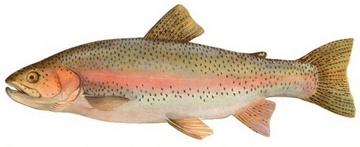The Rainbow Troutposted on 20 February 2015 | posted in Hints and TipsCommon name: Rainbow trout Latin name: Oncorhynchus mykiss  Record weight: Several fisheries specialise in growing huge rainbow trout with twenty pounders coming out on a regular basis. Current top of the tree is a monster of 36lb 14oz 8 drams. There is currently no wild record, although it is known that spawning populations have become established in Cumbria and Scotland. Distribution: Introduced to the UK and Europe from North America, the rainbow trout has found favour thanks to it's fast growth rate and less stringent requirements for high water quality than the native brown trout. Now found throughout the British isles. Features: Similar in shape to the brown trout, but can be distinguished by it's lighter colour and pinkish sheen. The tail and anal fin are much more heavily spotted than is found in the brown trout. Diet: In rivers rainbow trout will feed primarily upon the larvae of mayflies and caddis flies. In lakes, diet is very much dependent upon what food is available, although tiny corixid larvae and chironomid larvae often comprise a large percentage of the diet. Large individuals will also hunt small fish. Spawning: Although when they were originally introduced rainbow trout were thought to be incapable of spawning in the UK, several examples of wild spawned fish have thought to have been caught from rivers in England and Scotland. I have even heard stories of captures of the migratory form of the rainbow trout, the steelhead, having been caught from rivers in the North West of England. Spawning takes place between October and December, and is very similar to that of the brown trout. Growth: Rainbow trout are faster growing than our native brown trout, yet because they tend to be found in smaller, less fertile fisheries, their growth is often retarded. Most fisheries are made up largely of stocked fish that have been reared on fish farms. Some fish do manage to survive for several years though and can grow to double figures in the wild. Very large rainbow trout are produced by some farms specifically for release into sport fisheries. These very large fish are sterile and all of their energy is diverted into growth, rather than being wasted in producing the gonads |








.jpg)
.jpg)





